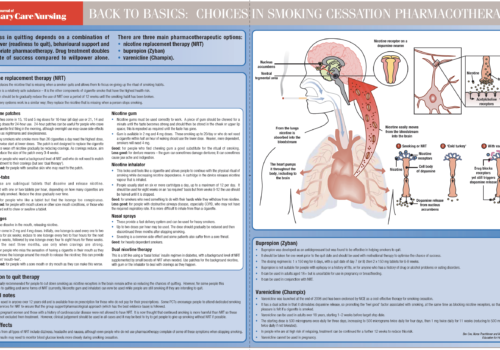Sitagliptin (trade name Januvia) is the first in a new class of drugs for diabetes – the dipeptidyl peptidase-4 (DPP-4) inhibitors. This new, oral hypoglycaemic agent has recently been approved for the treatment of type 2 diabetes. It is available on prescription and can be prescribed in primary care. Principal advantages include lack of weight gain and hypoglycaemia, which should make sitagliptin very popular with patients. This article looks at what a DPP-4 inhibitor is and how it works to lower blood glucose, as well as where this class of drug fits into current practice.
Back to Basics: Choices in smoking cessation pharmacotherapy
Optimising the prevention and management of obesity: putting NICE guidance into practice
Obesity is a rapidly growing problem in the UK. Department of Health statistics show that the prevalence of obesity in children under 11 years of age rose from 9.9% in 1995 to 13.7% in 2003, and in adults obesity prevalence has trebled since the 1980s, with more than 50%, (almost 24 million adults), now being classed as overweight or obese. In the article, we review the latest guidance from the National Institute for Health and Clinical Excellence (NICE) on how to prevent and manage obesity in practice.
Mending the growing problem of childhood obesity
There is no argument about the fact that childhood obesity in the UK is a serious problem. According to the Department of Health, childhood obesity affected 14.3% of 2-10 year olds in England in 2004. This was almost 5% more compared to the 1995 figures, and the estimated prevalence for 2010 is 20% if nothing is done, meaning that one million children will be obese. What can we do to reverse this growing epidemic of childhood obesity?
Phase II cardiac rehabilitation in primary care
Cardiac rehabilitation is an aspect of Coronary Heart Disease (CHD) management that many primary care health professionals admit to knowing relatively little about. In this article, we explore the central role of primary care in cardiac rehabilitation.
Heart disease in women: no longer a cinderella issue
You and your Treatment: Starting on Ezetimibe (Ezetrol)
Glitazones: All That Glitters…
Glitazones were rapidly incorporated into the management of patients with type 2 diabetes after their introduction. How do they work and when should we consider using them? And what should we make of recent discussions about the possibility of an increased risk of myocardial infarction with rosiglitazone?
Hands on Hypertension: Getting to Targets in Practice
Hypertension affects one in five people in the UK and is poorly managed despite a range of drug and lifestyle interventions known to be useful and effective. We are constantly reminded about the importance of getting people to target with blood pressure (BP) treatments but this can be easier said than done. In this article, we will look at the challenge of getting blood pressure readings down to target levels and we will work through some case studies to explore possible solutions to achieving the targets in practice.
Monitoring kidney function with eGFR
Around 2.9 million people in the UK have moderate-to-severe kidney disease. Estimated glomerular filtration rate (eGFR) can help to identify patients at high risk of cardiovascular disease (CVD) and improve the prevention and management of chronic kidney disease (CKD). In this article, we explain why it is important to detect CKD early, how eGFR is calculated and how to reduce risk in patients found to have impaired kidney function.
Pass the Salt: How to Cut Down
We’re recommended to eat a maximum of a teaspoon a day but nearly all of us eat more. Salt provides sodium which is needed in small amounts for maintaining water balance and is used in nerve activity – but too much can lead to serious health complications. How can we help our patients to cut down on their salt intake?
Chronic Wounds: Optimising Wound Management
Practice and other community-based nurses play a central role in achieving high quality wound care in patients treated initially in general practice and in those who have been discharged from hospital. This article summarises some of the wound management products available for chronic wounds, and the importance of continued wound care in the primary care setting, before focusing on one of the latest approaches – total negative pressure (TNP).





















